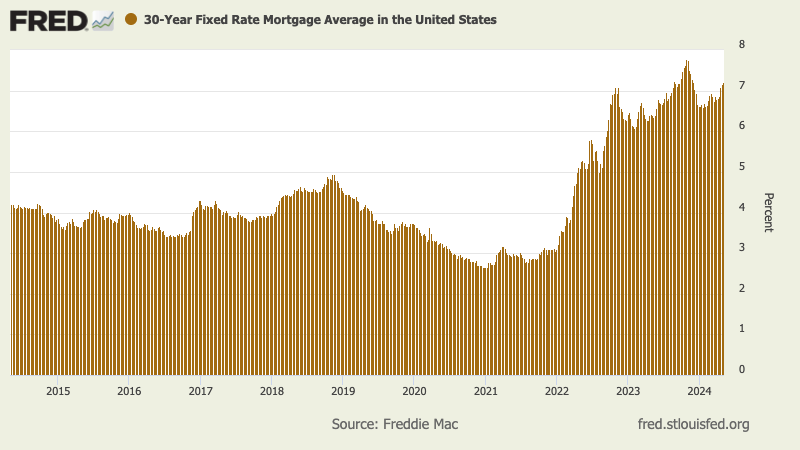
The average rate on a 30-year mortgage climbed this week to its highest level in more than five months, pushing up borrowing costs for prospective homebuyers in what’s typically the housing market’s busiest stretch of the year.
The rate rose to 7.22% from 7.17% last week, mortgage buyer Freddie Mac said Thursday. A year ago, the rate averaged 6.39%.
When mortgage rates rise, they can add hundreds of dollars a month in costs for borrowers. That limits how much homebuyers can afford at a time when a relatively limited number of homes on the market coupled with heightened competition for the most affordable properties has kept prices marching higher.
The average rate on a 30-year mortgage has now increased five weeks in a row. It hasn’t been this high since November 30 – just after Thanksgiving.
Borrowing costs on 15-year fixed-rate mortgages, popular with homeowners refinancing their home loans, also rose this week, lifting the average rate to 6.47% from 6.44% last week. A year ago, it averaged 5.76%, Freddie Mac said.
Related Articles
Fed says interest rates will stay at 2-decade high until inflation cools further
Mortgage rates climbs to highest level since November
Weekly mortgage rates are up, but prices are the real villain
Should Biden pressure the Fed to cut interest rates?
Mortgage rates jump to 5-month high
Mortgage rates are influenced by several factors, including how the bond market reacts to the Federal Reserve’s interest rate policy and the moves in the 10-year Treasury yield, which lenders use as a guide to pricing home loans.
After climbing to a 23-year high of 7.79% in October, the average rate stayed below 7% this year until last month, as stronger-than-expected economic data and inflation dimmed optimism among bond investors that the Fed would be able to start cutting its short-term interest rate sooner, rather than later.
In its latest interest rate policy statement Wednesday, the Fed said it doesn’t plan to cut interest rates until it has “greater confidence” that price increases are slowing sustainably to its 2% target.
Until then, mortgage rates are unlikely to ease significantly, economists say.
“Recent data reflects a surprisingly resilient economy, which means rate cuts expectations have pushed out further into the back half of the year,” said Hannah Jones, senior economic research analyst at Realtor.com.
The uptick in mortgage rates in recent weeks is an unwelcome trend for home shoppers this spring homebuying season. On average, more than one-third of all homes sold in a given year are purchased between March and June.
“With two months left of this historically busy period, potential homebuyers will likely not see relief from rising rates anytime soon,” said Sam Khater, Freddie Mac’s chief economist.
Sales of previously occupied U.S. homes fell last month as homebuyers contended with elevated mortgage rates and rising prices.
To cope with rising borrowing costs, some homebuyers are turning to adjustable-rate mortgages, or ARMs. These types of loans accounted for nearly 8% of all mortgage applications last week, the highest level this year, the Mortgage Bankers Association said Wednesday.
“Prospective homebuyers are looking for ways to improve affordability, and switching to an ARM is one means of doing that, with ARM rates in the mid-6% range for loans with an initial fixed period of 5 years,” said Mike Fratantoni, the MBA’s chief economist.
